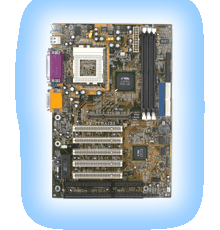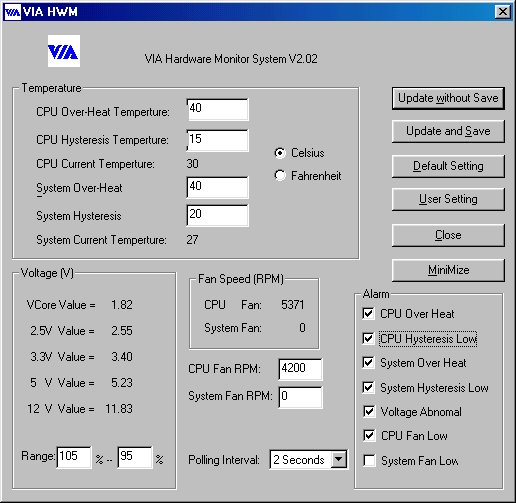Onboard
These days,
integrated peripherals are everywhere, sound, video, network, you name it,
it's been integrated. I find it funny, the look of disbelief on peoples faces
when I tell them that all I have is an integrated VIA AC97 combatible sound
card. But this one is actually not all that bad. The default setting really
pumps out the bass, so much so that you'll need to turn them down a little
to ease the distortion. Gaming, Wav, and MP3 playback is excellent. You don't
get any fancy EAX or A3D positional audio but it's quite livable. The problems
I did encounter are mostly related to older legacy games and MIDI audio (I still consider Warcraft 2 to be one of the best games of all time). You can enable legacy
Sound Blaster emulation in the BIOS, and it does work....sort of, if you turn
off MIDI. Trying to play any sort of MIDI sounds failed miserably, after playing
around with the settings the best I could get was a few scratches and pops
out of it. It's not a big loss, not many games nowadays use MIDI anyways,
but it's nice just to have for the couple times a year we all get the urge
to whoop some Orc butt.
 The
review board Soyo sent out also included an onboard hardware monitor which
is always very usefull. The manual does state that the monitor is optional,
so be sure to check that you do get a board with it. Alot of people dismiss
hardware monitors as useless, but I disagree. When you start overclocking
a system it's imperative that you know just how hot your CPU is running and
the minute a fan fails that you know about it. The provided VIA Hardware Monitor
application is basic fare, providing a simple window and system alarms. It's
simplistic, but quite functional and that's what counts. Motherboard Monitor
4.x works great with the board, providing much more complex monitoring and
alarms. It's great to leave the system on all night knowing that if a CPU
fan happens to fail, the system will shut itself down safely.
The
review board Soyo sent out also included an onboard hardware monitor which
is always very usefull. The manual does state that the monitor is optional,
so be sure to check that you do get a board with it. Alot of people dismiss
hardware monitors as useless, but I disagree. When you start overclocking
a system it's imperative that you know just how hot your CPU is running and
the minute a fan fails that you know about it. The provided VIA Hardware Monitor
application is basic fare, providing a simple window and system alarms. It's
simplistic, but quite functional and that's what counts. Motherboard Monitor
4.x works great with the board, providing much more complex monitoring and
alarms. It's great to leave the system on all night knowing that if a CPU
fan happens to fail, the system will shut itself down safely.

Conclusion
All things
considered, the Soyo 7VBA is a pretty good board. For new systems that you
don't want to spend loads of cash on, the 7VBA is a good choice for it's many
features and especially 133MHz FSB which is going to be the standard very
soon. Although for existing BX users and overclockers, this would not be a
top choice board. The disappointing RAM performance and questionable overclocked
stability are detrimental. The BIOS issues encountered should be fixed very soon, and that will eliminate one of our major complaints. We wern't quite sure what to expect from the VIA Apollo Pro 133 chipset, we had heard both good and bad things about it, but it managed to shine in all areas except for the RAM performance.
Overall, the Soyo 7VBA133 is a worthy board. Not because of it's outstanding performance, or features, but because it manages to do pretty much anything you want to throw at it. The onboard AC97 sound performed much better than expected, pumping out excellent bass, the winbond monitor is a nice addition, and the overclocking options are top notch.
Andrew
Oliver September 28, 2000
